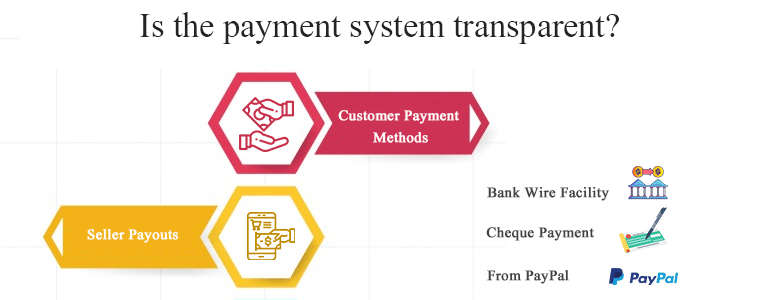The appropriate marketplace features help you to support an increasing group of buyers or sellers, promote a variety of products or services, and drive sales.
There are some recent and evolving marketplace trends that you’ll have to keep in mind if you are an aspiring digital entrepreneur who is willing to take advantage of all those customers and sellers stepping into online business.
Most individuals understand the eBay and Amazon marketplace model; it is essentially a system in which goods can be sold by any company or person and pay a fee on each sale to the site owner. We will look at the features that make the online marketplace a strong one.
We have discussed how to create a marketplace in our previous blog post. Today, we will look at some particular marketplace features in these posts, such as distribution, returns, and checkouts, as well as how to develop one with a marketplace extension.
1.What Revenue Models your Marketplace have?
Once you start looking for a marketplace module, the very first question arises is how you will earn the profit? What kind of revenue business model the module will support? Several revenue models like commission, subscription plan, product listing fees, ads, and marketing charges are popular but the most lucrative one is the commission model. The seller has to pay a fixed amount (percentage of amount) to the owner of the marketplace as a commission. Admin earns money on behalf of every order placed.
Next in the row is subscription or membership plans. The seller will have to take the membership plan in order to list the product. The plan can be divided into two levels: Product listing fees, the validity period.
Store admin can charge for marketing and advertisement or as payment processing fee on every transaction seller makes.
What does Magento 2 Marketplace Module offer? The extension for the multi-seller marketplace has two revenue models: commission and membership plan. The seller has to choose a plan as per the requirements and number of products he wants to sell. The commission can be charged equal to all the sellers or different from every seller as decided by the store owner. You can read the article in which we have covered the commission model entirely.
2. Admin interface should be manageable
The admin interface of the marketplace module or software should be easy to handle and configure. While choosing the right module make sure it has all the functionality required to manage the marketplace. See if you can approve the registered sellers; see their transaction reports, sales and earnings, customer reviews, and other necessary functionalities.
The admin interface of the Magento 2 Marketplace extension is easy to install and configure. It allows the store owner to disable a seller if his reviews are poor or reward if he is doing good. The Magento module displays sales reports, the earnings and sales can be tracked. Marketplace managers can see orders, review the products before publishing, and assign categories to the seller.
3. Mobile Friendliness
Netizens’ population is increasing, with that, the number of smartphone users in the world has reached 5.2 billion by 2020. Understanding the demand you must have a module that makes your marketplace completely gadget friendly. It should be mobile responsive because the research suggests that people shopping from mobile phones are way more than desktop.
The Magento 2 multi-seller module is completely mobile responsive and works well with other gadgets too. It doesn’t hinder the loading spend instead works smoothly.
4. Can the seller promote his own brand?
For online retailers, the logo symbolizes trust and brand dedication. To identify company promises and branding for online marketplace products, a simple and outstanding logo may also be used. Perfectly built, it has reassuring characteristics and confidence values that help draw more users.
A sleek and trendy homepage with minimalist features, a logo, and a captivating image and video can be generated by famous brands that can also convince visitors to press the ‘Order’ button.
The multi-vendor marketplace of Magento 2 enables sellers to add banners for sales, shop logo, and custom HTML content. These banners with different product collections will be shown on the seller’s side.
5. Is the payment system transparent?

Customer Payment Methods:
Ecommerce apps can get orders from customers located in any part of the world now that we live in a highly competitive, globally linked world. And consumers prefer an effortless payment system, including credit cards, debit cards, digital wallets, PayPal, or COD. These are primary online purchase options whose icons can be clearly shown in the top corners or near landing page banners or in the menu section, alternatively.
Seller Payouts:
For seller payouts, different methods are supported by Magento 2 Marketplace extension. You can choose the one you would like to use for the payouts.
By default, there are three methods available:
- Bank Wire Facility
- Cheque Payment
- From PayPal
6. Product Listings and inventory management
In an online marketplace, you cannot hold the product in hand and feel the material or smell the food to check if it is fresh or not. Customers miss this while shopping through an eCommerce. So, you can provide a high-quality image and all the possible information on the product page. It is sometimes good to add a video of the product because visuals with movements create a better impact.
To manage the inventory some marketplace extensions like Magento 2, allow the vendors to import/export the products in bulk from the page and add as many as he wants to. This reduces the extra effort and time spend.
7. Seller Dashboard

The seller dashboard should be fully functional and easy to handle. While looking for the features in a marketplace extension, this is the most important one because you will be able to attract sellers only if the management and handling are simple.
The Magento 2 marketplace has several admins, sellers, and customer benefits and these will dwell the users. The seller can manage every small thing from his end and get notified for everything.
8. Customers can share products on social media

Another feature you should look for is social connect. The seller can create a profile and link it to social media platforms like Facebook, Google, Twitter, and Instagram. Social connections increase the customer base and brand awareness. This is the low cost (cheapest) marketing strategy to increaseour reach.
9. Ratings & Reviews builds trust
Look for a marketplace extension which has an option for customers to give product feedback. Social proofs like product reviews increase trust and customer loyalty. Genuine reviews help them in choosing the right product.
The marketplace module for Magento 2 allows the customers to put the rating and review both for the product and the seller.
10. Send alerts and notify with email and notification
The seller should know about the stock alert, receive inventory notifications, and other important notifications to manage the product listing on time. The Magento 2 Multi-Vendor Marketplace Module has an Email Templates tab which includes a list of all the email templates that are used in the framework. The email template includes all the necessary details and can be customized if required.
11. Who can manage the orders
As a store admin, you cannot take all the responsibilities on your head but it will be great if you can divide some with the sellers as well. A marketplace module in which orders can be managed by both the owner and the seller will be good enough. It will reduce the workload and the seller would be able to maintain the inventory himself.
With the Magento 2 Marketplace module, both the admin and the seller can see and update the order status with the approval of the owner.
12. Does the marketplace allow order return and refund?
When digging into the features do not forget about customer satisfaction. Every business requires higher retention because it is difficult to find new leads than bringing back old customers. If you want your customers to shop again then make sure that your marketplace has a sturdy return and order cancellation policy.
If a customer is not satisfied with the quality of the product or received a faulty one then he can raise a request to return the product and will get the refund as per the policy rules. This feature is incorporated in the Magento 2 module.
13. Shipping methods enlisted in the marketplace module
Shipping methods should be convenient and affordable. The marketplace should have some adequate shipping methods and it will be fine if you can allow the seller to add some of the shipping methods which is reliable and acceptable for them.
In Magento 2 marketplace plugin, the seller can add several shipping methods or choose from the methods listed by the marketplace owner.
14. Assistance with the help and support system
The standards of customers for customer service continue to rise. We live in an era of convenience where we want everything and we want it immediately!
Developing a multichannel approach means that you need to know and be there where your clients are, whether it’s Facebook, Instagram, WhatsApp, or Live Chat. Your marketplace should have a system to raise a ticket in case of queries or concerns.
The Marketplace addon designed for Magento 2 has a feature for the customer-seller support ticket system. Customers can raise a ticket and see the status from the marketplace front interface.
15. Language & Currency
To spread the business globally you will need upstanding language support. The marketplace should have multi-lingual features and multiple currency support.
Magento 2 Marketplace is compatible with multiple languages. Also, email templates are available in different languages. For currency, it supports several currencies and the admin can set the default currency for the transactions.
Wrap up:
Don’t worry if you can’t introduce the most beautiful killer features right now, start small. In the end, you should note that the best online platforms are continuously developing and there is no limit to perfection. That’s why the marketplaces remain ahead of every other.
And if you’re interested in how to start an online marketplace, read this article in which we talk about all the benefits of the marketplace.
And note that our Knowband team not only provides an outstanding service for the growth of the e-commerce marketplace but we will be happy to consult you on your new venture.
The marketplace addon is also available for PrestaShop and OpenCart platforms.





